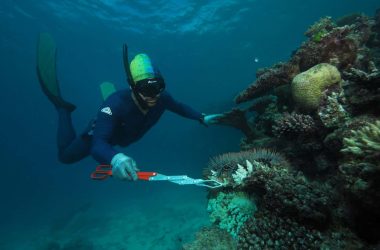A Megymenum stink bug
Younger Swee Ming/Shutterstock
Feminine stink bugs have a weird organ that they use to domesticate a backyard of fungi, which in flip helps defend their eggs from a species of parasitic wasp.
Takanori Nishino on the Nationwide Institute of Superior Industrial Science and Know-how in Tsukuba, Japan, and his colleagues discovered this organ when finding out the hind legs of Megymenum gracilicorne, a stink bug recognized to infest cultivated cucumbers and pumpkins.
The researchers had been how females use the tympanal organ of their hind legs, a type of eardrum that bugs use to listen to sounds, throughout mating. They discovered the females had a small, porous indent of their legs, stuffed with fungal tendrils referred to as hyphae. Every feminine had cultivated a number of fungal species inside this organ, with a stunning quantity of range.
What’s extra, this was no unintended progress. Because the females deposited their eggs, they scratched on the fungal-filled pores with the claws of their different leg, then rubbed the eggs with their claws, smearing them in fungi. Inside a number of days, the eggs had been fully lined within the hair-like hyphae. When the younger nymphs hatched., they retained this fungal coating till they moulted.
At first, the crew thought that the fungi might present a poisonous or pathogenic barrier to predators, however additional evaluation revealed that a lot of the varieties had been innocent.
The thriller deepened till the researchers studied stink bug eggs within the wild and located they had been continuously parasitised by a beforehand undescribed wasp, now named Trissolcus brevinotaulus. They found that the wasp lays its eggs contained in the stink bug eggs, however is thwarted when the hyphae are thick sufficient. The wasps have their very own trick, nonetheless, because the females have thicker antennae than the males, which can be used for breaking via this thicket of hyphae to put their eggs, in response to the crew.
“I’ve by no means seen a real bug [the order that stink bugs belong to] use fungus this fashion,” says Nikolai Tatarnic on the Western Australian Museum in Perth. “Egg parasitism is a big threat to many bugs, particularly these whose eggs are laid uncovered, versus buried in soil or in plant tissue,” he says. “I’m certain that after studying this, all of the bug individuals might be wanting via their dinidorid [the family stink bugs belong to] collections and searching once more on the tympanal organs of the females.”
He says there’s a precedent for the same egg safety technique, although. “Varied murderer bugs that hunt utilizing plant resins have been proven to retailer resin, which in addition they use to coat their eggs – a lot in the identical approach as these stink bugs.”
Matters:












